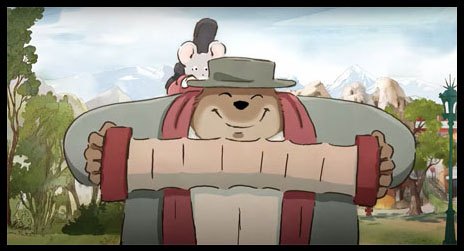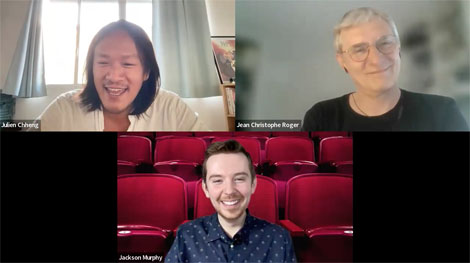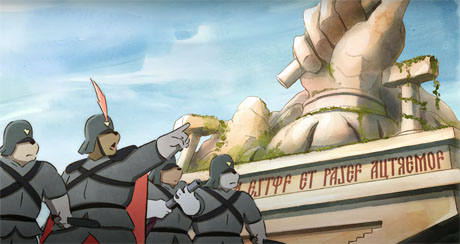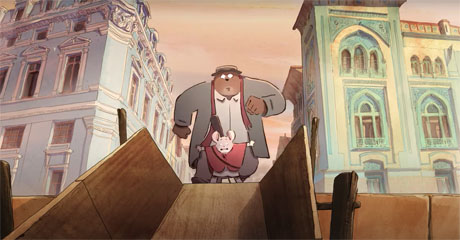
10 years ago, hand-drawn film Ernest & Celestine, about the unlikely pairing of a bear and a mouse, charmed moviegoers and Academy members. It earned a Best Animated Feature Oscar nomination alongside Hayao Miyazaki’s final film at the time, The Wind Rises, and CG blockbusters Frozen, The Croods and Despicable Me 2. This Friday September 1st, GKIDS will release a sequel feature in theaters, with the title characters on their biggest and most meaningful journey yet. Here’s my conversation with the directors of Ernest & Celestine: A Trip to Gibberitia, Jean-Christophe Roger and Julien Chheng. (This Animation Scoop Q&A was edited for length and clarity.)
Jackson Murphy: Jean-Christophe, what did you love about these characters the very first time you saw them?
Jean-Christophe Roger: Well, it’s an example of, “How far can a friendship go between two so different people?” Celestine has big dreams. Everybody would say, “It’s not possible.” But Ernest would never say that. Ernest loves Celestine. He wants to make her happy. He wants to make everything happen even if it’s not possible. I love this kind of relationship, and the drawings of Gabrielle Vincent, who is so wonderful. I always dreamed to work on that project. I was so lucky to work with Julien on the series and now this new feature film.

JM: Amazing. Julien, what were your goals with advancing the story with this sequel but also, for fans of the original, making callbacks?
Julien Chheng: We love the first movie. Our challenge was to get to the same kind of technique and artistry that we love. We take those characters into wilder places. Gibberitia is a whole new world that we created. The film really talks about more serious and mature issues. We go back into Ernest’s past and discover why he actually fled from his home country. We wanted to do it in a very entertaining, funny and absurd way, but also talk about different layers of what happens today in the real world.
JM: There are a lot of great observations about society and life that we see throughout Ernest’s home of Gibberitia. Jean-Christophe, tell me about the visual aspects of the town that you wanted to convey in the film.
JCR: From the beginning, we took some influence from eastern countries. Old houses. It’s far away. We were looking for something [like] France and we created this very deep valley. It’s a remote place, where people live without connection or contact with other people. It’s connected to the streets.

Julien,Jean-Christophe, and Jackson
JM: It looks so good and the details really come through. And one of the interesting things you focus on with the story is music. Music beyond the C-note is banned. Julien, why did you want to focus on the importance of music in our lives?
JC: Music is so important in everyone’s life. For us, it was a metaphor. They enter a country where only one voice is allowed. One note is the way of how [it is] in this country, with their strict rules. When Celestine enters that world, she doesn’t agree at all that there should just be one voice. She wants to liberate all the notes and all those voices. That for us was the multi-layered message we could talk about with this film — for children to actually question all those rules, all those people who want them to do a certain type of job. We think children are very intelligent and should really express themselves and pursue their own passions and find their own ways. They should succeed in that, if they follow their passion and their heart.
JM: Yeah. Using your voice. Using the voice that you have — the power you have — to make change and to make things happen. That is really good. Ernest’s broken violin really sets the story in motion. Jean-Christophe, [are there] any instruments that have influenced you throughout your life?
JCR: My daughter is playing the violin. She used to tell me, “No. That’s not the way you should draw it. It doesn’t work that way!” (laughs) It was important to make it real and realistic. But the main thing is: the violin is broken, so Ernest is very [mad] and very unhappy. Celestine absolutely wants Ernest to be happy, and she can cross the universe and brave the tempest only to make a friend happy again. She’s sincere and she goes so far to help Ernest.

JM: Definitely. And Ernest’s parents have such strong personalities. His mother is a doctor. His father is a judge. Julien, how did you want to present these parents with such strong emotions behind them?
JC: Well, we were influenced by our own parents, obviously. (laughs) Jean-Christophe and I were not meant to become filmmakers or even artists. I think that’s also our own history that we put out there. I think that the judge is very much like my father. He really wanted me to become an engineer or doing mathematics, like him. He was, like the character, very funny and very out there, but also very strict when it comes to having a role in public. And for the mother, she’s very funny. She can maybe listen a bit more. She’s very active. She’s working all the time. While looking at the parents, there’s no surprise why Ernest is so… weird. (laughs) And bad-tempered sometimes. His parents are very all over the place.
JM: (laughs) There are a lot of good scenes with them. Jean-Christophe, one of the visuals in the movie that I love is the two sides of the house separated. How did you come-up with that visual? It’s a wow moment.
JCR: There are different ways of creating. Some people create by writing on the computer and ideas come. Our way of working is that ideas come through drawing too. You read something and you start to draw and the ideas come. So it just came naturally. We wanted to show the separation. It came very naturally to have this kind of idea because Gibberitia is an absurd world. It’s like this and not otherwise. It’s not made to make the people happy. It’s just absurd without caring about the people. We had to make things in a way that’s a little bit absurd but also have meaning.

JM: It’s very cool and there’s absolutely a lot of meaning behind it. Julien, I want to ask you about some of the technical challenges because a lot of the movie involves sound and key mechanisms. There’s a snowstorm rescue early on that’s really well done.
JC: Our intention was to really have the audience sucked into the story and the journey. We wanted to grab the attention of anyone who’s watching. It revolves a lot around music. We asked our composer, Vincent Courtois, to compose the music very early on, so that based on his music and the rhythm, we could create the structure of these high intensity sequences. That’s how we think it works well between the visuals and the music. It’s kind of a choreography and it’s very appealing.
JM: Memorable sequences. For both of you, what does it mean to you that Ernest and Celestine are always there for each other, even when they disagree and even when things get difficult? When you break it all down for these two characters, there’s a lot of power there.
JCR: Celestine’s great. She’s very small, but her heart is huge. Even when Ernest pushes her away, “Go. I don’t want to see you again.” She doesn’t hate him. She doesn’t give up. She can understand that he’s suffering and is stuck in a difficult situation. She only thinks about how she can save her friend. She’s so great. And this is what I admire a lot. Even though she’s not real, she embodies the greatness of the human heart.
JC: Celestine takes Ernest’s problems as if they were her own. I like the line in the movie where she says, “If it’s your family, they are my family too.” That’s exactly how she is. Ernest is a part of her and she’s part of Ernest. She can help be his other part and they complete each other.
- INTERVIEW: Strap In For “Mars Express” - April 30, 2024
- INTERVIEW: Jeff Fowler On “Knuckles” And “Sonic 3” - April 22, 2024
- INTERVIEW: “Inside Out 2” Director And Producer On Pixar Sequel - April 16, 2024


 August 28th, 2023
August 28th, 2023  Jackson Murphy
Jackson Murphy  Posted in
Posted in  Tags:
Tags: 






